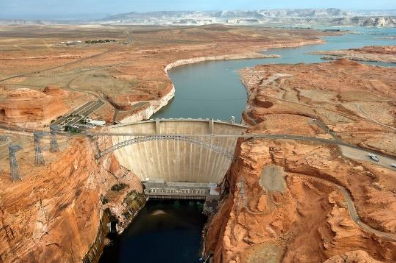The Lower Colorado River represents a unique river environment that harbors eight types of native fish. These species flourished in the turbulent, sediment-rich waters of the Grand Canyon and developed many unique morphological traits as a result. However, the recent introduction of non-native species and the construction of hydropower dams along the river has put these populations at risk. Mollie Ogaz, an ecologist at UC Davis, recently outlined the status of these native species, the threats they currently face, and the management plans for their protection and recovery.

Unique adaptions of native fish
Historically, the Colorado River was a difficult place to be a fish.
Extreme yearly flooding, variable temperatures, turbulent rapids, and
large influxes of sediment created an inhospitable environment. Uplift of the Colorado Plateau meant that the basin itself was spatially isolated from other river systems. This combination of extreme environments and isolation contributed to the evolution of a small number of highly- adapted fish. Six of these are endemic to the Colorado River, which is one of the highest rates of endemism in North America.
These species developed unique morphological traits to survive in the waters of the Grand Canyon. This includes large, streamlined bodies to better navigate rapids, long lifespans to maximize reproductive success, and fins and scales specially formed to maintain body position in a muddy turbulent river. To defend against a gape-limited native predator (Colorado Pikeminnow) some species also developed bony head perturbances – the characteristic humpback. These adaptations were specific to a muddy, single-predator Colorado River that flooded yearly, but the unique nature of these adaptations means that a change in environment or introduction of a new predator can be hugely detrimental to these fish species.
Threats to native species
Native fish are primarily threatened by two main factors – the construction of dams and the introduction of non-native species. The Glen Canyon Dam opened in 1966, and forever changed the morphology of the Grand Canyon section of the Colorado River. Muddy, warm, turbulent water became clear, cold, calm water. Yearly
flooding was virtually eliminated by the controlled dam flows, which halted the creation of sandbar-protected backwater environments necessary for fish spawning. Native fish lost much of their natural river habitat and the sudden change in environment rendered their specialist adaptions useless.

The introduction of non-native fish species was detrimental to native fish as well. The non-native fish were introduced as sport fishing stock, but their generalist adaptions meant that they flourished in the Lower Colorado River, especially after dams shifted the river environment from a very harsh to a more moderate system. Their success came at the expense of the native fish, who lost space and resources to these newcomers. The non-native fish preyed on native fish, who were “predator naïve” when it came to dealing with fish who hunted by sight in the newly- clear waters. The juvenile populations were especially vulnerable to predation, creating a population crisis where most remaining fish are adults, with no replenishing juvenile populations to continue the species.
The damage to native species from dams and non-native fish can already be seen – two native fish species are no longer found in the Lower Colorado and four are considered endangered. Protecting these remaining species is an important policy consideration even though it is a complex process.
Recovery and restoration efforts
Restoring the Colorado River back to its pre-human state is almost impossible. However, recovery and restoration efforts can be made to protect remaining native species. The Grand Canyon Adaptive Management Program focuses on a multi-pronged approach to protecting native species, including mechanical removal and ecosystem recovery. The physical removal of non-native fish can help native populations because it removes the competition for resources and space, in addition to removing a top predator. Mechanical removal of non-native fish has been semi-successful, but it is not a long-term, sustainable solution.
Restoring the Colorado River closer to its former state – muddy, turbulent, and with flooding – can encourage native populations to thrive. The high flow experiments are designed to mimic natural flooding of the Colorado River, introduce more sediment into the system, and restore natural habitats of native fish. So far, the high flow experiments have had mixed results, with population growth seen in both native and non-native species. Management of native fish species in the Grand Canyon has considered the needs of sport fishermen, who depend on non- native populations of trout to support world-class fly fishing. Creating a comprehensive plan to protect native fish species while addressing the needs of fishermen is a difficult, complex, but important part of preserving the unique Colorado River ecosystem.
